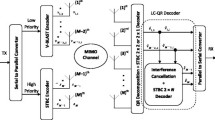Abstract
This paper investigates the detecting algorithm for MIMO system, in which the Multi-layered orthogonal space-time block code (OSTBC) is employed to transmit the data symbols. First, the matched filter design problem based on maximizing the SINR of each layer is investigated, which is characterized as a generalized eigen-value problem that can be efficiently solved by the Generalized Rayleigh-Quotient (R-Q) Theorem. Then a new efficient space time detecting algorithm is proposed for Multi-layered OSTBC with this R-Q matched filter, in which first a linear recombination strategy is applied on the received signal to construct a high-dimensional equivalent channel derived from the OSTBC encoding pattern, as a joint characterization of channel fading and OSTBC encoding. Then using the high-dimensional equivalent channel matrix, a group of R-Q matched filters are designed to effectively extract the receive signal of the desired layer and suppress the interference from other layers. Finally, linear decoding is used to detect the transmitted symbols by exploiting the OSTBC-induced structure in the equivalent channel matrix of each layer after interference cancellation. Furthermore, the proposed algorithm in presence of the channel estimation error is also analyzed. Theory analysis and simulation results reveal that the proposed algorithm has the benefits of good robustness, better BER and capacity characteristics.








Similar content being viewed by others
References
Foschini, G. J., & Gans, M. J. (1998). On limits of wireless communications in a fading environment when using multiple antennas. Wireless Personal Communications, 6(3), 311–335.
Foschini, G. J. (1996). Layered space-time architecture for wireless communication in a fading environment when using multi-element antennas. Bell Labs Technical Journal, 1(2), 41–59.
Wolniansky, P. W., Foschini, G. J. & Golden G. D. et al. (1998). V-BLAST: An architecture for realizing very high data rates overthe rich-scattering wireless channel. In Proceedings URSI international symposium on signals, systems and electronics (pp. 295–300). New York, USA, September 1998.
Tarokh, V., Seshadri, N., & Calderbank, A. R. (1998). Space-time codes for high data rate wireless communications: Performance criterion and codes construction. IEEE Transactions on Information Theory, 44(2), 744–765.
Tarokh, V., Jafarkhani, H., & Calderbank, A. R. (1999). Space-time block coding for wireless communications: Performance results. IEEE Journal of Selected Areas Communication, 17(3), 451–460.
Tarokh, V., Naguib, A., Seshadri, N., & Calderbank, A. R. (1999). Combined array processing and space-time coding. IEEE Transactions on Information Theory, 45(4), 1121–1128.
Dai, L., Sfar, S., & Letaief, K. B. (2007). A quasi-orthogonal group space-time architecture to achieve a better diversity-multiplexing tradeoff. IEEE Transactions on Wireless Communication, 6(4), 1295–1307.
Dai, L., & Letaief, K. B. (2005). An efficient detector for combined space-time coding and layered processing. IEEE Transactions on Communications, 53(9), 1438–1442.
Jung, S., & Lee, J. (2009). A new ML based interference cancellation technique for layered space-time codes. IEEE Transactions on Communications, 57(4), 930–936.
Stamoulis, A., Al-Dhahir, N., & Calderbank, A. R. (2001). Further results on interference cancellation and space-time block codes. IEEE Asilomar SSC, 1, 257–261.
Fan, X., Zhang, H., Luo, H., & Huang, J. (2006). Optimal MMSE successive interference cancellation in group-wise STBC MIMO systems. Journal of System Engineering and Electronics., 17(1), 85–90.
Gomaa, M., & Ghrayeb, A. (2007). A low complexity MMSE detector for multiuser layered space-time coded MIMO systems. Proceeding of IEEE electrical and computer engineering, (pp. 617–620). Vancouver, BC, Canada, April 2007.
Onggosanusi, v, Dabak, A. G., & Schmidl, T. M. (2002). High rate spacetime block coded scheme: Performance and improvement in correlated fading channels. In Proceeding of IEEE wireless communication networking conference (pp. 194–199). Orlando, USA, March 2002.
Kim, H., & Park, H. (2005). Efficient successive interference cancellation algorithms for the DSTTD system. In Proceeding of IEEE personal indoor and mobile radio communications (Vol. 1, pp. 62-66). Berlin, Germany, September 2005.
Jung, S., & Lee, J. (2009). A new ML based interference cancellation technique for layered space-time codes. IEEE Transactions on Communications, 57(4), 930–936.
Diggavi, S. N., Al-Dhahir, N., & Calderbank, A. R. (2003). Algebraic properties of space-time block codes in inter-symbol interference multipleaccess channels. IEEE Transactions on Information Theory, 49(10), 2403–2414.
Wu, Y., & Tellambura, C. (2006). Low-complexity optimal detection for hybrid space-time block coding and spatial multiplexing. In Proceeding of IEEE vehicle technology conference fall (pp. 1–4). Montreal, Canada, September 2006.
Golub, G. H., & Van Loan, C. F. (1996). Matrix computations (3rd ed.). Baltimore, MD: The John Hopkins University Press.
Author information
Authors and Affiliations
Corresponding author
Additional information
This work was supported in part by the National Natural Science Foundation of China (61101069, 61201135, 61201134); The 111 Project (B08038); the National Key Project of New Generation Broad Band Wireless Communication (2012ZX03001027-001) The Fundamental Research Funds for the Central Universities (72115696).
Rights and permissions
About this article
Cite this article
Hei, Yq., Li, Wt., Li, Xh. et al. Efficient Rayleigh-Quotient Detector for Multi-layered Orthogonal STBC System. Wireless Pers Commun 72, 2029–2045 (2013). https://doi.org/10.1007/s11277-013-1120-1
Published:
Issue Date:
DOI: https://doi.org/10.1007/s11277-013-1120-1



